Towards a Whatever Architecture
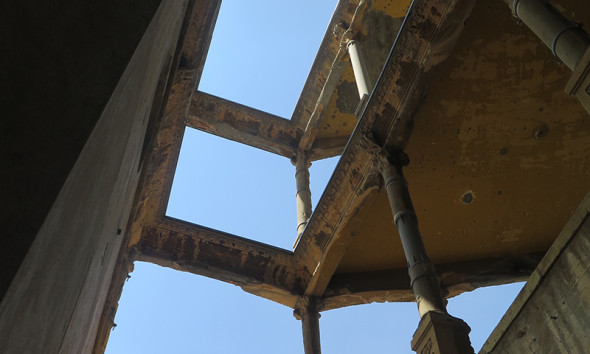
With The Ethics of a Potential Urbanism: Critical encounters between Giorgio Agamben and Architecture the architect, urbanist and educator Camillo Boano is contributing to a renewed critical encounter with architecture’s political function.
“Agambenian politics1 consist of a subtraction from the apparatuses of power that govern the identities and prescribe roles and positions [and the corresponding dispositifs, which, for Agamben include anything that has in some way the capacity to capture, orient, determine, intercept, model, control, or secure the gestures, behaviors, opinions, or discourses of living beings], rendering them inoperative and then reclaiming its own inoperativity. (…) A new ethics of a potential urbanism is not a pervasive call for activism with more reality and relevance and less theory; rather, it is an ethical shift – a radical alteration of the project of design. The project herein is theoretical and practical, critical and transformative, a truly radical theory and critical practice. (…). An inoperative architecture (…) stands as a new manifesto for action, reclaiming Bartleby’s powerful motto: ‘I would prefer not to.’”
A review on Camillo Boano’s The Ethics of a Potential Urbanism can, due the logic inherent in Boano’s reflections, only be a potential, ultimately inoperative, one. One that tries to detach as much as possible from prevalent categories and tropes, is driven by the incessant presence of an absence, is aware of its own pitfalls and the partiality of the author (not an architect, but a meanderer between disciplines, even though still rooted in and coined by her academic studies; being familiar with Agamben’s work, but not having read it entirely). A potential review tries to draw from its seeking mode, from an inherent tentativeness, instead of trying to conceal it; is aware of the own inappropriateness; inevitably a potential critique is written by a person who “would prefer not to.”
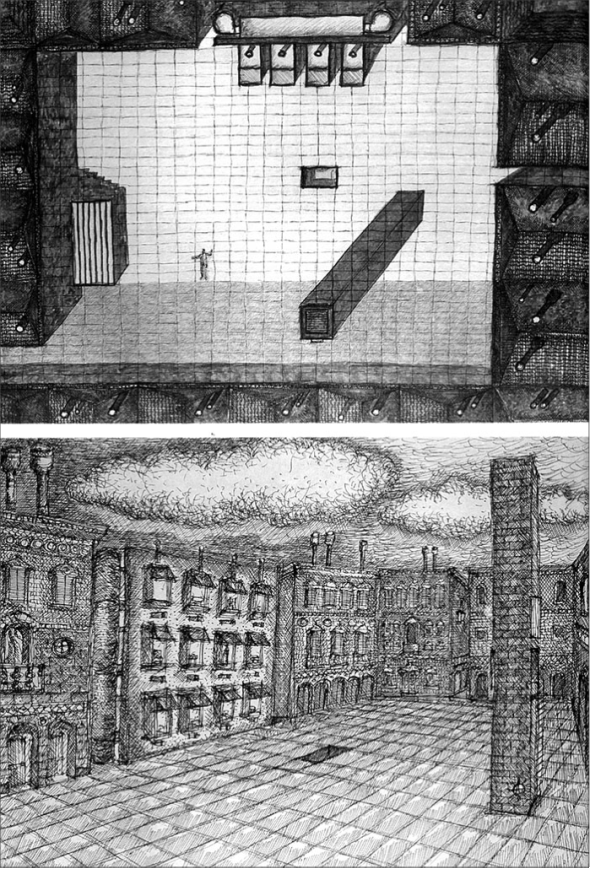 I’d prefer not to. The Thirteen Watchtowers of Cannaregio, John Hejduk. Source
I’d prefer not to. The Thirteen Watchtowers of Cannaregio, John Hejduk. Source
“Only an unwritten review could comply with this claim,” those persons might say, whose interpretation of Agamben differs from Boano in a very crucial point. For them, Hermann Melville’s Bartleby the Scrivener, recently rediscovered as a poster-figure of the “new weariness,” is a waverer, a herald of utter capitulation or a dovelike insurgent; they see the “activist potential” of this figure exhausted in his refusal to act at all. But from Boano we learn that Bartleby’s refusal happens in a very specific mind-set acquired in a thought-process that ultimately also the readers of The Ethics of a Potential Urbanism are asked to adopt. This thought-process – to which we will have a closer look on the following lines – is geared by the acknowledgement, or a re-recognition, of one’s own impotence, and by the re-dimensioning of the range of one’s own potential: “today’s man believes himself capable of everything and so he repeats his jovial ‘no problem,’ and his irresponsible ‘I can do it,’ precisely when he should instead realize that he has been consigned in unheard of measure to forces and processes over which he has lost all control. He has become blind not to his capacities but to his incapacities. (…)”.
Bartleby is clear about his potential and impotence, his “I’d prefer not to” entails the possibility of doing as much as also the possibility of not to do. “It is not that he does not want to copy or that he does not want to leave the office; he simply would prefer not to.” In this formula, Boano explains, the possibility of constructing a relation between being able and willing is destroyed, it deflates the (in the context of The Ethics of a Potential Urbanism: neoliberal) imperative notion of potentiality to produce and realize itself in work; the speaker eludes the power of the governing apparatuses. “Bartleby’s potentiality exceeds will (his own and that of others) at every point, it is not exhausted in actions, it is a potentiality that retains its potential for being ‘impotential’ for not passing into actuality.” Bartleby thus manifests a generic mode of potentiality. A potentiality that is not exhausted in being transferred into action and thus is able to resist being co-opted by the prevailing logics of the governing system. In generic potentiality human beings are mirrored as such that they cannot be defined by any proper operation – as “beings of pure potentiality that no identity or vocation can possibly exhaust.” They are “whatever beings”, “post-sovereign” figures of un-coded existence, consisting in anything in particular, anything essential, depending on any standard of conformity or normality. Those beings are not determined by “whatever necessities,” they are leading a life “in which the single ways, acts and processes of living are never simply facts but always and above all possibilities of life, always and above all power.” The “unitary power that constitutes the multiple forms of life as form-of-life” is, as Agamben suggests, akin to the Marxian “general intellect,” which informs the “coming community” whose realization we ultimately all are striving for, if we act along an Agambenian notion of “coming politics.”
It is this conception of generic potentiality underlying a “form-of-life,” which is closely connected to the concept of inoperativity. Inoperativity then “is always a matter of action, but an action that loses any links with purpose, signifying gratuitousness and [true, supreme] potentiality, an action that enables us to probe the possibilities of forms-of-life outside the governmental apparatuses.” Inoperativity thus can be described as acting in present times but out of our time (informed by a future to come, in which a possibility beyond the actual state and potentiality are preserved). “If (…) inoperativity can (…) be deployed only through a work, then the corresponding political concept can no longer be that of ‘constituent power’ [potere costituente], but something that could be called ‘destituent power’ [potenza destituente]. (…), in order to think a destituent power we have to imagine completely other strategies, whose definition is the task of the coming politics.” And in analogy to architecture “It is a destituent mode of thinking and practicing architecture and urbanism that can possibly redeem architecture and urban design from its social emptiness, cultural irrelevance, economic reductionism or proto-avant-garde extravagance, contributing to a renewed critical ‘encounter’ with architecture’s aesthetic-political function and a ‘little different’ practice” that sets the base for a “coming architecture,” or a “whatever architecture” as “being such that it always matters.”
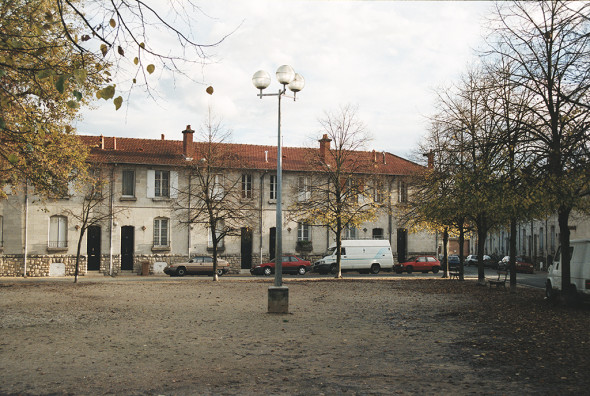 Inoperative withdrawal. Léon Aucoc Square, Lacaton & Vassal. Source
Inoperative withdrawal. Léon Aucoc Square, Lacaton & Vassal. Source
After this lengthy introduction, some readers might already feel tempted to give in. But they should know that by explaining some of the Agambenian concepts wrapped in The Ethics of a Potential Urbanism, and – by musing on what a potential critique might entail – anticipating and trying to adopt some of the central findings of Camillo Boano, the preceding lines aimed to exemplify first and foremost one thing: Agamben’s politics can be considered a “philosophical invention,” since his work is full of sweeping ambition and programmatic claims – fragmentary and improvisational in their intellectual exploration, refusing to make any specific suggestions that reach beyond evocative recommendations, abounding from paradoxes and contradictions and pushing these paradoxes even further. Without ignoring their obfuscating character – and drawing on their affirmative tendency – Boano subtracts from those writings his suggestion of an architectural (and deeply political) activism entailing a by all means practical notion that is about getting rid but not about giving up. And yet, even if Boano’s suggestions can find their way into everyday architectural practice – despite its practicability – every Agambenian activity always starts with a thinking-exercise searching to adequately map one’s actual conditions: the own entanglement within the hegemonizing dispositifs. An inoperative architecture always entails a thoughtful process of embracing “openness and confrontation with one’s impotence: that is, grasping and experiencing each one’s incapacity, an ethics before actualization, and an ethics of potentiality effective precisely because there is no clear-cut moral certainty.”
It is thus in the nature of things that The Ethics of a Potential Urbanism cannot be just another guide to better architectural or urban practice. Boano underlines Agamben’s believe in “unity between theory and struggle against any dogmatism of ideas – or put differently, a materiality of thoughts on the one hand, and the theoretical value of political acts, on the other.” And, translated to his discipline: “Rather than being the legitimization for architecture and urban design as strictly practical, disciplinary domains fixed within institutional frameworks, philosophical thought could help them return instead to their raw condition of possibilities,” to a whatever architecture ultimately. He thus proposes “to use Agamben’s lens on theories and concepts and some of his obscured reflections to imagine alternatives to the complicit and silent predicament of architecture and city production in late capitalism.”
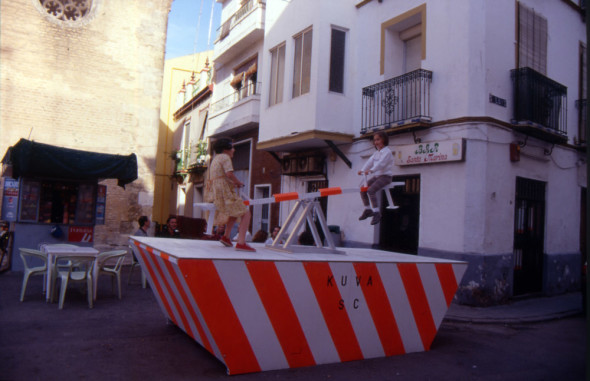 Overcoming dispositifs. Kuvas S.C., Recetas Urbanas. Source
Overcoming dispositifs. Kuvas S.C., Recetas Urbanas. Source
Camillo Boano in his book propagates a thoughtful, “slowed-down” activism, an activism which is no longer (secretly or less secretly) claiming recognition by or inclusion in (Western) ideals of humanity and promises of economic growth and financial recognition, but instead is constantly searching for and engaging in a de-linking from the confines of language, signification, law and history, and thus also capitalism and politics as we know it. Those reflections and the call for a (re-)politicization of architecture through a destituent practice are timely: addressing a world, where under the veneer of democratization, political activism, feminism and all the rest of them we see valuable and relevant struggles diluted, depoliticized, slick-ified, made “instagrammable”, and protests serve as yet another embellishment for the immaculate (self-)image offering instant and pre-emptive absolution from whatever indifferent notion of guilt.
Boano is very aware of his discipline where the “motto of doing, acting and not wasting time” is still overtly present. Thus in his explanations he discusses his topic on different levels – once indulging in philosophical abstraction, once offering hands-on suggestions; and he herewith absorbs the risk of losing those readers, who are less familiar with dialectical intellectual argumentation. He not only manages to make Agamben’s thoughts perceivable trough discussing and mirroring them against architectural considerations, but also manages to harness his works for the conception of an architecture to come.
Given the complexity and ambiguity of Agamben’s work and recalling Boano’s aim to think philosophy as intrinsic to architecture, his clear statement of reading Agamben as an architect, and not as a philosopher or political economist, is relevant. Because here – paradoxically, one could argue – disciplines matter. Only by adopting a very specific focus and addressing a specified group (by deliberately choosing words and ontologies, that, strictly spoken, cannot be valid as such anymore, as the principled affirmation of inoperativity makes it logically impossible to discuss politics, law, history or disciplines in the traditional terms) allows to frame the vast reservoir of Agambenian thoughts and exemplifying them to the biggest possible extent. Boano’s focus on architecture and urbanism also legitimates that, except acknowledging Agamben’s controversial reception, he widely veers away from further delving into those discussions and critiques around Agamben’s work, which i.a. deny him any political vigor (Paolo Virno), and which are, at least to a certain extent, also cock fights, hen-and-egg-questions between, among others, post-Marxist (Italian) philosophers.
Boano also cold-shoulders some of the most striking irregularities in Agamben’s oeuvre, e.g. the for him decidedly binary conception of man-animal (which he does not overcome even in his latest work dealing with anthropocentrism). But only like this – not wandering from his subject – Boano can focus on a stringent declination of his interests, a meticulous tracing down, juxtaposing, connecting, reflecting and mirroring Agamben against the defined setting of “the discipline known as architecture,” again and again breaking his argumentations down to a level of minor complexity. He dissects Agamben’s concepts, arguing his way through the layers and sediments of Agambenian argumentation, including politics, (ancient) history, religion, metaphysics, theology, semiotics, medieval literature and cinema. To exemplify his argumentation, Boano traces down Agamben’s (few) direct references to architecture, urban and spatial elements, as well as the concepts that informed Agamben’s work and Agamben’s influence on actual architectural projects or conceptualizations. In these regards, he is also able to clear misunderstandings and uncover half-cocked appropriations, to which Agamben’s work despite (or exactly because of) its opacity invites. Boano is well aware that “the discipline of architecture, planning and urban design uses Agamben’s reflections to inspire and illustrate spatial exclusionary principles and exceptional topologies in order to elucidate some specific geographies or urban issues”, and he highlights the danger of “importing [Agamben’s works] from outside architecture and urban studies, and use them as conceptual gestures rather than framing a critical reflection around the multiple possible encounters that his oeuvre has in imagining alternatives to the complicit and silent predicament of architecture and city production in late capitalism.”
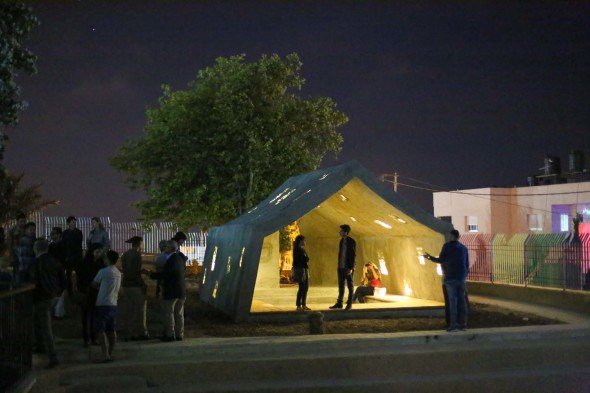 Unlearning and subversion. Campus in Camps, DAAR. Source
Unlearning and subversion. Campus in Camps, DAAR. Source
The main message that Boano subtracts from his involvement with Agamben is in principle a simple one. He centres Agamben’s writings towards an offense of “contemporary culture of architecture, urban design and planning, [where] the dominant ontology of enactment and largely unquestioned practice is simply pointing at the existent order of roles, people and places, without a fundamental critique that permanently exposes the inequalities that ground most social systems, together with the legitimating apparatuses of that system”. That system with its shape shifting qualities, which could reproduce itself in any other configuration if needed, in The Ethics of a Potential Urbanism is called capitalism. Boano is completely aware of the mechanisms by which the system is running: “A power that was only just overthrown by violence will rise again in another form, in the incessant, inevitable dialectic between constituent power and constituted power, violence which makes the law and violence that preserves it.” So ultimately “Being radical or mainstream, activist or complacent, are all terms being co-opted by the prevailing cultural logic of capitalism, and thus unable to disentangle themselves from the operativeness of the actual, in a continuous and accepted theoretical regression.”
Boano knows that the problem which he is dealing with is not only the one of “reading Agamben into architecture” or the other way round, but one of touching the sore spot of the structural and mental dysfunctions of the discipline as such, its encrusted structures, hierarchies, the violence and repression that still dominate it. Ultimately asking for a fundamental revision of what it means to be a person: the modern circumscriptions of citizenship, family, religion, ethnicity, and other calls to an essential identity that exceeds a “whatever being.” It’s a delicate and Herculean task to call on individuals to engage themselves in self-critique, being immersed in a discipline which – despite some exceptions – still thrives from big egos, grand gestures (even in what they call “social” or “activist architecture”), and draws from the more or less secretly nourished conviction that the architect is the saviour (or at least powerful influencer) of the world and its course – even more as Boano advocates for a self-criticism which is not complacent and jaded and thus passive, but one searching, propellant and playful (in an Agambenian sense). To then introduce his colleagues to the fact that they “(…)are not the sovereign subjects of a creative operation and of a work” is even more challenging. Boano, coherent to his claim, once again relies on diligent argumentation, meticulous derivation and the disclosure of his argumentation. In its severity his tone here and there tends towards sermonizing and patronizing. But the end justifies the means (to bother a proverb attributed to Machiavelli but featured in a much more appealing way by McSolaar in his song “La fin justifie les moyens”)2.
In the sake of the clearness of his argument Boano even risks some loyal side blows, as in the passage “The 2016 Venice Biennale curator, Alejandro Aravena, somewhat followed that masculine motto of doing, acting and not wasting time or architectural intelligence, while aligning perfectly with an activist gesture (herein used in the sense of taking the entire process, from design to production, into his own hands). The narrative is focused on making and doing on behalf of the ‘common good’, in the ‘public interest’ or to achieve ‘social impact’ (…) Aravena’s gestures, postures and aesthetics seem to represent a new frontier of ‘archistarism’, with the adoption of social agendas and ‘do-goodism’, normalized and domesticated in the neo-liberal discourse by abandoning and neutralizing the radical critical originality. (…) It does become a legitimizing dispositif for the neo-liberal production of architecture and space: oversimplifying political, social and economic questions from the purview of designers; diminishing ambitions and critical power by diverting attention to pragmatism and an urgent need to act.”
Even if this is put clearly, can pleas like this be enough to rouse the ones entangled so deeply in the matrix? Let us recall the words of a wise man, Morpheus (the author herewith confesses her serious crush on this figure), addressing “The Matrix’s” main character Neo: “The Matrix is a system, Neo. That system is our enemy. But when you’re inside, you look around, what do you see? Businessmen, teachers, lawyers and carpenters. The very minds of the people we are trying to save. But until we do, these people are still a part of that system and that makes them our enemy. You have to understand, most of these people are not ready to be unplugged. And many of them are so inured, so hopelessly dependent on the system, that they will fight to protect it.” True. Also in our case. Also Boano can’t, of course, even by the most circumspect argumentation, avoid that Aravena becomes yet another scapegoat, an excuse to dislocate and depersonalize a discourse, to deviate tackling the own dependency from the system, justifying the tendency to – even though in most of the cases unwillingly – fighting to protect the Matrix, or at least being complicit in keeping it intact by, just as Aravena, “materializing an autonomy-narrowing architecture with a design mission that caters to an uncritical acceptance of the status quo, dressed with social intentions.”
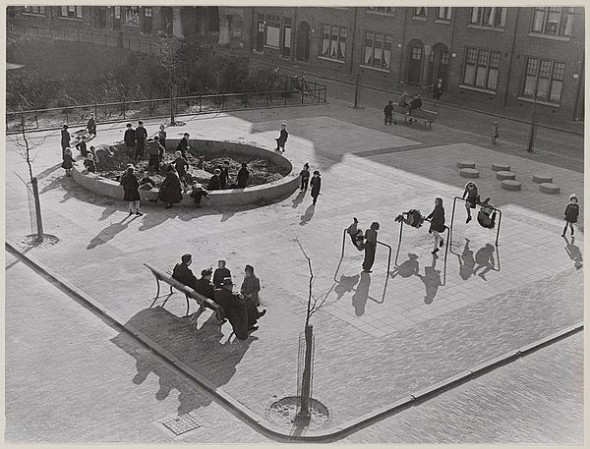 Ambivalence, in-betweens, thresholds. Playground, Aldo van Eyck. Source
Ambivalence, in-betweens, thresholds. Playground, Aldo van Eyck. Source
Knowing that his aim to “sell” his colleagues, who still mainly perceive of architecture and design as operative, practical, concrete, tangible and problem-solving-oriented, an inoperative architecture, “a making that makes use of its possibility to not make,” is a difficult one, Boano, in his aim to explain the combination of the affirmation of inoperativity and an affirmative project of emancipation, again finds the right manner to condense conceptual considerations and translate them into an eupeptic message: “a resistance to oikonomic government does not mean the utter rejection and removal of all dispositifs, or their overturning, but a withdrawal from the oikonomic system and leading a life that does not accept the logic of dispositifs. Agambenian politics consists of a subtraction from the apparatuses of power that governs the identities and prescribes roles and positions, rendering them inoperative and then reclaiming its own inoperativity. (…) A new ethics of a potential urbanism is not a pervasive call for activism with more reality and relevance and less theory; rather, it is an ethical shift – a radical alteration of the project of design. The project herein is theoretical and practical, critical and transformative, a truly radical theory and critical practice. To be radical means to be about the root, the origin of something; but a truly radical theory and critical praxis needs to be vigilant, contrasting the neutralization of political messages around justice, space and urbanism. An inoperative architecture (…) stands as a new manifesto for action, reclaiming Bartleby’s powerful motto: ‘I would prefer not to.’”
As we have seen, Agamben’s activism delivered through Boano is not about big gestures, not about mobilization, organization, civil society and aggregations, or plotting a revolutionary event. It is about a basic and generic resistance percolating every sphere of (in our case) human life and architectural disciplines: it merely requests subtraction of the subject from existing apparatuses, whereby they appropriate their own potentiality of whatever being. To once again frame his thoughts and to underline the practicability of an “inoperative architecture” Boano uses an analogy with the Situationists’ détournement, which also heavily influenced Agamben: “By relying to this concepts [Agamben] suggests [détournement] as a practice offering a shift to a totally different meaning, a critique of the capitalist commodification of all aspects of life through the misappropriation of existing spaces with determined uses, able to determine a use that is different from the one the capital had ‘assigned’ to that particular piece of urban fabric.” A claim, which leads Boano to suggest architecture to reconfigure its matrix of reference conceiving of “inoperative architecture as an architecture, an urban design, ‘just a little bit different’, yet capable of deactivating the sociospatial dispositifs while mobilizing a new theory and a new project for the urban now to come.”
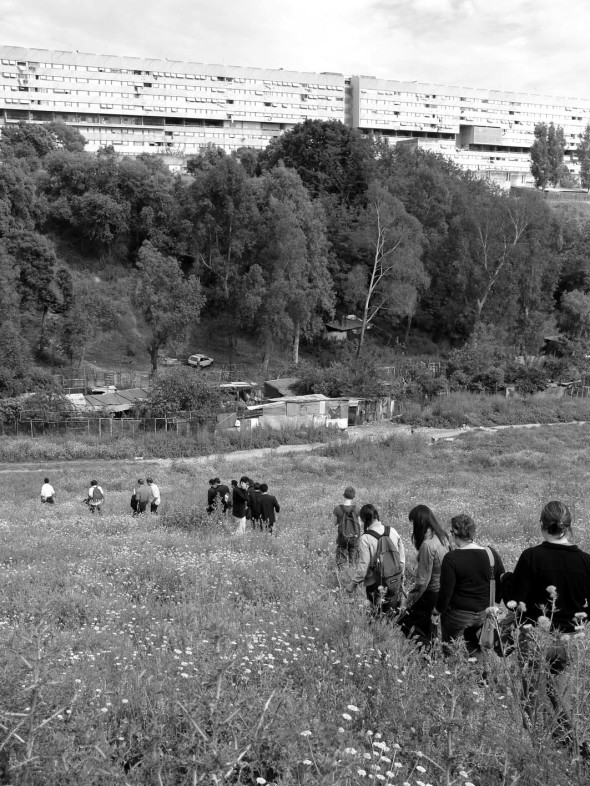 Détournement. Immaginare Corviale, Stalker Osservatorio Nomade. Source
Détournement. Immaginare Corviale, Stalker Osservatorio Nomade. Source
As Agamben himself is nor accounting for the process of the constitution of the political subject (let alone projecting the inoperative community of whatever being to come), nor demonstrating why this step outside would be taken by the subjects of contemporary societies, it is left to Boano to suggest viable paths to his colleagues, which he does to a certain extent by introducing several illustrative practice examples. But ultimately it is up to the reader to imagine what the “urban now to come” or the “coming community” might entail. It certainly is already inscribed into a present, in which a consciousness about the mechanisms of assimilation and control exerted on us by the system is developed. A present like this carries in itself a potential future, where this awareness is reflected in an immanent dis-sensus and a generic disobedience directed against the totalizing power of the dispositifs. For practicing architects and urbanists – but also any other individual – such a present might entail to stop perceiving concepts such as efficiency, visibility, marketability, income and hierarchical positions as the benchmarks for personal and professional success; and to shift their values away from the prevalent evaluation criteria, the terminologies, orientation and evaluation grids forced upon them by a system, which is driven by market economy, global competition, mainly white Western history, and built on the foundations of discrimination, segregation, rejection; and strengthened by fear, paralysis and alienation. Instead they may develop a new orientation grid that offers them new affordances of perception and action, of motivation and reward – together with and within the other. Recognizing the other then is nor a matter of being physically, professionally or geographically close, nor depending on a prevalent notion of “acquaintance” (let alone on categories such as human, artificial or animal), but it means to be related to the other in a state of whatever being. This might form the base for a coming community, a form-of-life, “a life which is lived immanently and therefore not reliant upon dispositifs to be constituted, nor any form of transcendence,” which through the rejection and immanent overcoming of sovereignty converts exclusion into autonomy.
This is, in all its indistinctions, a hopeful prospect, located in the premises that we don’t know what will happen and that in the spaciousness of uncertainty is room to act towards a future to come; it entails to embrace the unknown and the unknowable, paradoxes and contradictions, opacities and open endings.
Notes
1. Agamben’s notion of “comingpolitics” is produced through a critical engagement with the existing traditions of political thought and practice and a reconsideration of what these traditions exclude as non-political. Through this he aims to advance a thoroughgoing alternative to the entire political tradition, which we continue to inhabit, or – in Agamben’s terminology –, render it inoperative. This means that his politics are not yet practiced, nor fixed in form of a regime or system, but rather remain to be invented. Agamben’s politics are neither pointed towards a teleological fulfilment of a process nor their own extinction, but rather draw their power from an affirmation of the sheerpotentiality of the subtraction from the governing apparatuses, and from the emancipatory possibility embedded in neutralizing their ordering force by harnessing a destituent power. Only by rendering it inoperative, in deactivating it, we can open something to a new possible use, whose definition is the task of the coming politics. The same principle is not only used to de-functionalize prevalent perceptions of politics, but also for dispositifs such as law, history, and ontological categories.
2. This detail is somehow important as this “earworm” echoed in the head of the author of this article throughout the writing process and must have influenced the text in a not nearer definable way
Author
Rebekka Kiesewetter studied art history, economy and modern history. She is a design and architecture editor, author and curator; a visiting lecturer at FHNW Academy of Art and Design, Basel, and a managing editor for Spector Books and co-director of Depot Basel. She is interested in developing and enabling agonistic sites for exchange and knowledge production through various formats, beyond prevalent disciplinary protocols and institutional constraints.
Info
title > The Ethics of a Potential Urbanism: Critical encounters between Giorgio Agamben and architecture
author > Camillo Boano
publisher > Routledge
pages > 188
year > 2017
price > £ 88.00
Questo sito usa Akismet per ridurre lo spam. Scopri come i tuoi dati vengono elaborati.








Lascia un commento